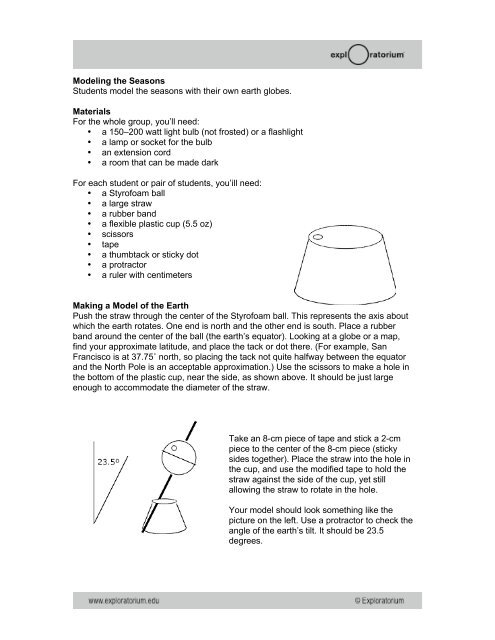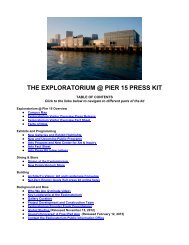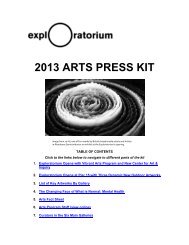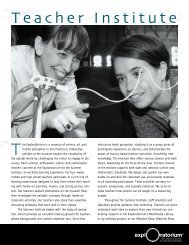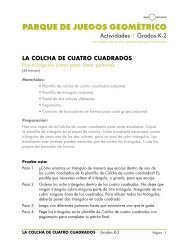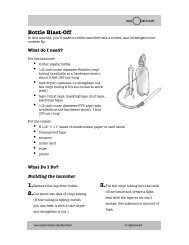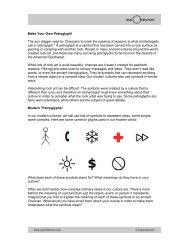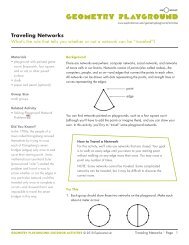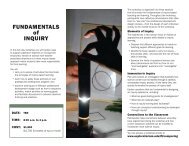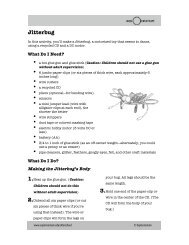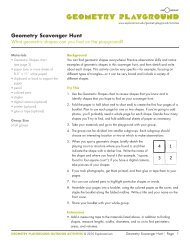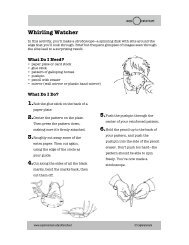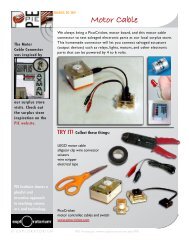Modeling the Seasons Students model the seasons ... - Exploratorium
Modeling the Seasons Students model the seasons ... - Exploratorium
Modeling the Seasons Students model the seasons ... - Exploratorium
Create successful ePaper yourself
Turn your PDF publications into a flip-book with our unique Google optimized e-Paper software.
<strong>Modeling</strong> <strong>the</strong> <strong>Seasons</strong><br />
<strong>Students</strong> <strong>model</strong> <strong>the</strong> <strong>seasons</strong> with <strong>the</strong>ir own earth globes.<br />
Materials<br />
For <strong>the</strong> whole group, you’ll need:<br />
• a 150–200 watt light bulb (not frosted) or a flashlight<br />
• a lamp or socket for <strong>the</strong> bulb<br />
• an extension cord<br />
• a room that can be made dark<br />
For each student or pair of students, you’ill need:<br />
• a Styrofoam ball<br />
• a large straw<br />
• a rubber band<br />
• a flexible plastic cup (5.5 oz)<br />
• scissors<br />
• tape<br />
• a thumbtack or sticky dot<br />
• a protractor<br />
• a ruler with centimeters<br />
Making a Model of <strong>the</strong> Earth<br />
Push <strong>the</strong> straw through <strong>the</strong> center of <strong>the</strong> Styrofoam ball. This represents <strong>the</strong> axis about<br />
which <strong>the</strong> earth rotates. One end is north and <strong>the</strong> o<strong>the</strong>r end is south. Place a rubber<br />
band around <strong>the</strong> center of <strong>the</strong> ball (<strong>the</strong> earth’s equator). Looking at a globe or a map,<br />
find your approximate latitude, and place <strong>the</strong> tack or dot <strong>the</strong>re. (For example, San<br />
Francisco is at 37.75˚ north, so placing <strong>the</strong> tack not quite halfway between <strong>the</strong> equator<br />
and <strong>the</strong> North Pole is an acceptable approximation.) Use <strong>the</strong> scissors to make a hole in<br />
<strong>the</strong> bottom of <strong>the</strong> plastic cup, near <strong>the</strong> side, as shown above. It should be just large<br />
enough to accommodate <strong>the</strong> diameter of <strong>the</strong> straw.<br />
Take an 8-cm piece of tape and stick a 2-cm<br />
piece to <strong>the</strong> center of <strong>the</strong> 8-cm piece (sticky<br />
sides toge<strong>the</strong>r). Place <strong>the</strong> straw into <strong>the</strong> hole in<br />
<strong>the</strong> cup, and use <strong>the</strong> modified tape to hold <strong>the</strong><br />
straw against <strong>the</strong> side of <strong>the</strong> cup, yet still<br />
allowing <strong>the</strong> straw to rotate in <strong>the</strong> hole.<br />
Your <strong>model</strong> should look something like <strong>the</strong><br />
picture on <strong>the</strong> left. Use a protractor to check <strong>the</strong><br />
angle of <strong>the</strong> earth’s tilt. It should be 23.5<br />
degrees.
Setting up <strong>the</strong> Room<br />
Use one bright lamp for <strong>the</strong> whole group or flashlights for small groups. Designate some<br />
visual reference as Polaris, <strong>the</strong> North Star. All straws should point to Polaris throughout<br />
<strong>the</strong> activity.<br />
Set up <strong>the</strong> light in <strong>the</strong> center of <strong>the</strong> group or flashlights in <strong>the</strong> center of each small group.<br />
Before darkening <strong>the</strong> room, make sure all earth <strong>model</strong>s are oriented correctly toward<br />
polaris. Darken <strong>the</strong> room.<br />
To Do and Notice: Model a “Day” on Earth<br />
Each student should turn <strong>the</strong> straw so that <strong>the</strong> earth spins counterclockwise (when<br />
viewed from <strong>the</strong> north) for one rotation. They should notice that <strong>the</strong> dot is in light (day)<br />
for about half of <strong>the</strong> rotation and is in shadow (night) for about half of <strong>the</strong> rotation.<br />
<strong>Modeling</strong> <strong>the</strong> <strong>Seasons</strong><br />
Divide <strong>the</strong> class into four groups. Have each group move to one of <strong>the</strong> four seasonal<br />
positions around <strong>the</strong> lamp (or one student at each position around a flashlight if using<br />
small groups): December 21, March 21, June 21, and September 21. It should look like<br />
this if seen from above:<br />
Have each group <strong>model</strong> a day at each position. At each position, <strong>the</strong>y should notice:<br />
• For what fraction of <strong>the</strong> day is <strong>the</strong> dot in <strong>the</strong> light? More than half? Less than<br />
half? About half?<br />
• For what fraction of <strong>the</strong> day is <strong>the</strong> North Pole in <strong>the</strong> light?<br />
• How is <strong>the</strong> light from <strong>the</strong> sun striking <strong>the</strong> dot? Is it direct or at an angle?
For example, on December 21:<br />
Angle at or above equator, direct below equator<br />
<strong>Modeling</strong> a Year<br />
After students have been to each of <strong>the</strong> four dates: December 21, March 21, June 21,<br />
and September 21, <strong>the</strong>y’ll have <strong>model</strong>ed a year: one earth revolution around <strong>the</strong> sun.<br />
What’s Going On?<br />
Many people think <strong>the</strong> <strong>seasons</strong> are caused by variations in our distance from <strong>the</strong> sun.<br />
While <strong>the</strong> earth’s orbit is slightly elliptical, it’s very close to circular, and <strong>the</strong> variation in<br />
distance between <strong>the</strong> earth and sun is not enough to account for our <strong>seasons</strong>. The<br />
<strong>seasons</strong> are caused by <strong>the</strong> tilt of <strong>the</strong> earth. The earth holds its rotation axis (tilt) fixed in<br />
space as it moves around <strong>the</strong> sun. In <strong>the</strong> summer, <strong>the</strong> Nor<strong>the</strong>rn Hemisphere tilts toward<br />
<strong>the</strong> sun. It’s warmer because (1) <strong>the</strong>re are more hours of daylight, providing us with<br />
more heat energy, and (2) <strong>the</strong> midday sun shines more directly head on, increasing <strong>the</strong><br />
amount of solar energy <strong>the</strong> earth receives. In <strong>the</strong> winter, when <strong>the</strong> Nor<strong>the</strong>rn Hemisphere<br />
tilts away from <strong>the</strong> sun, <strong>the</strong> sun’s rays strike <strong>the</strong> earth at a lower angle, and <strong>the</strong> energy<br />
from <strong>the</strong> sunlight is spread out over a larger area, which reduces its effectiveness at<br />
heating <strong>the</strong> ground. Combined with shorter daylight hours, <strong>the</strong> temperatures are cooler<br />
in winter. The <strong>seasons</strong> in <strong>the</strong> Nor<strong>the</strong>rn and Sou<strong>the</strong>rn Hemispheres are opposite.
Teacher Tips<br />
for <strong>Modeling</strong> <strong>the</strong> <strong>Seasons</strong><br />
Grade Level<br />
5-8<br />
National Standards Addressed<br />
Grades 5-8:<br />
Earth and Space Science: Earth in <strong>the</strong> Solar System<br />
Science as Inquiry: Design & Conduct Investigation, Analyze & Interpret Data, Develop<br />
Explanations, Think Critically<br />
Key Concepts<br />
<strong>Seasons</strong>, rotation of <strong>the</strong> earth, earth's axis, day and night, earth's orbit around <strong>the</strong> sun.<br />
Background Science<br />
<strong>Seasons</strong> of <strong>the</strong> year<br />
http://www-istp.gsfc.nasa.gov/stargaze/Sseason.htm<br />
What causes <strong>the</strong> <strong>seasons</strong>?<br />
http://www.crh.noaa.gov/fsd/astro/season.htm<br />
Earth's <strong>seasons</strong> (narrated animation)<br />
http://kids.msfc.nasa.gov/earth/<strong>seasons</strong>/Earth<strong>Seasons</strong>.asp<br />
BBC Science and Nature: The <strong>Seasons</strong><br />
http://www.bbc.co.uk/science/space/solarsystem/earth/solsticescience.shtml<br />
Ideas for Discussion<br />
• The sun dagger petroglyph (see link below) was a way for <strong>the</strong> Chacoans to know<br />
when <strong>the</strong> <strong>seasons</strong> were changing. Why would this be important for <strong>the</strong>m?<br />
Sun dagger petroglyph:<br />
http://www.exploratorium.edu/chaco/HTML/sundagger.html<br />
• How do you know when <strong>the</strong> <strong>seasons</strong> are changing? Do you use signs that <strong>the</strong><br />
Chacoans may have used? What modern signs tell you that <strong>the</strong> <strong>seasons</strong> are<br />
changing?<br />
• How does <strong>the</strong> change of <strong>the</strong> <strong>seasons</strong> affect you?<br />
Related Media<br />
• Our <strong>Seasons</strong> has a description of how sunlight is affected by <strong>the</strong> earth's tilt and<br />
orbit: http://www.exploratorium.edu/chaco/HTML/<strong>seasons</strong>.html<br />
• See an animation showing how <strong>the</strong> sun moves across <strong>the</strong> horizon throughout <strong>the</strong><br />
year (requires <strong>the</strong> Flash Plugin):<br />
http://www.exploratorium.edu/chaco/HTML/TT-<strong>seasons</strong>.html
• See an animation showing how <strong>the</strong> area of <strong>the</strong> globe that is in sunlight changes<br />
throughout <strong>the</strong> year (requires <strong>the</strong> Flash Plugin):<br />
http://www.exploratorium.edu/chaco/HTML/<strong>seasons</strong>.html<br />
• What Time Is It on Mars?<br />
A Webcast exploring time and <strong>seasons</strong> on <strong>the</strong> Red Planet (requires Real Player):<br />
http://www.exploratorium.edu/mars/mars-040107.ram<br />
Going Fur<strong>the</strong>r<br />
• Revisit <strong>the</strong> year stations. Notice <strong>the</strong> angle at which <strong>the</strong> sun strikes your dot<br />
during <strong>the</strong> summer versus during <strong>the</strong> winter. In which season are you <strong>the</strong> most<br />
likely to get sunburned? Why?<br />
• Imagine you’re living on <strong>the</strong> equator. How would you describe <strong>the</strong> change of<br />
<strong>seasons</strong>?<br />
• Now imagine that you’re at <strong>the</strong> North Pole in <strong>the</strong> summer. What path does <strong>the</strong><br />
sun take across <strong>the</strong> sky?<br />
Check for Understanding<br />
• What special aspect of <strong>the</strong> sun's position or movement do we mark with <strong>the</strong><br />
solstices and <strong>the</strong> equinoxes?<br />
• What would <strong>seasons</strong> on <strong>the</strong> earth be like if <strong>the</strong> axis weren't tilted?


